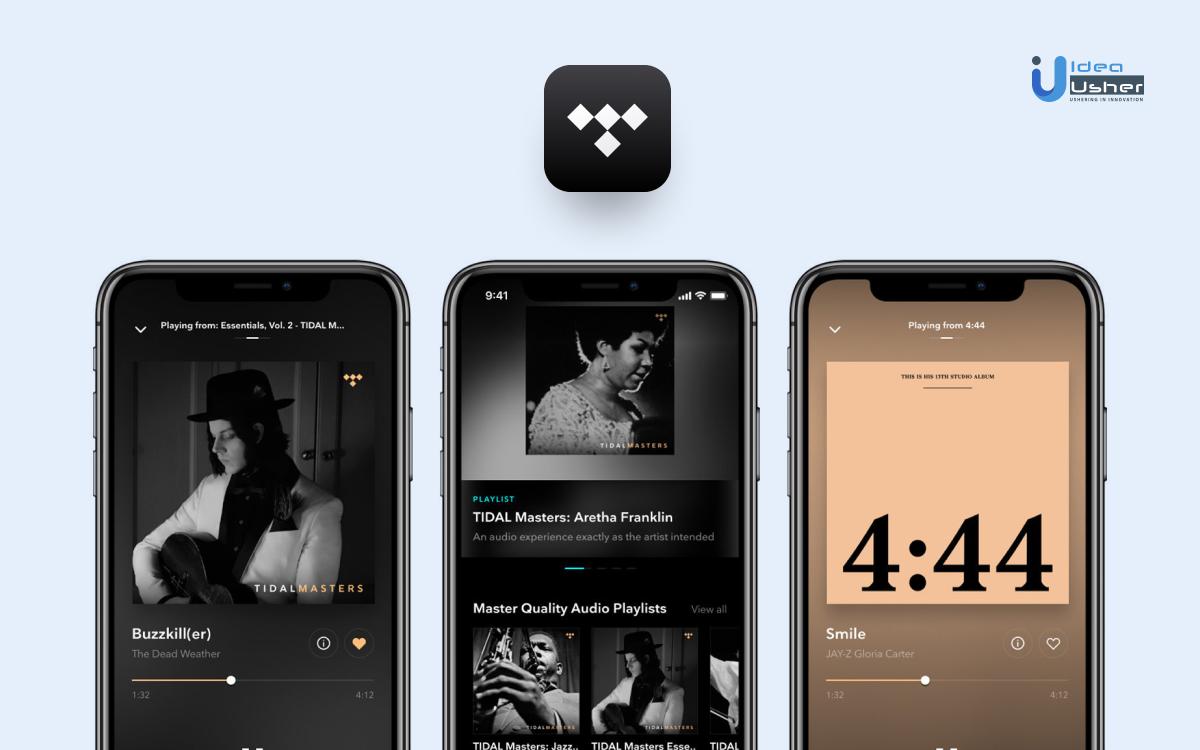- What is a music streaming app, and how does it work?
Market Overview- Current market leaders
- App Development Process: Points To Consider
- Features of a music streaming app like Tidal
- Cost (according to the features)
- Monetization methods
- Stages of Music App Development
- Why to Choose Idea Usher
- FAQ's
- Q. How can you ensure the security of a music streaming app?

It seems that the internet has made our lives simpler in many ways, and one of those ways is by making it easier for us to access and listen to music. Online music streaming services have now dominated the experience of using CDs or cassettes.
YouTube is a major source of music streaming, but it has its drawbacks. For example, it’s difficult to download music, and you have to stay online constantly.
This led to many music streaming apps like Tidal, SoundCloud, iTunes, Grooveshark, Spotify, and Google Play.
- What is a music streaming app, and how does it work?
Market Overview- Current market leaders
- App Development Process: Points To Consider
- Features of a music streaming app like Tidal
- Cost (according to the features)
- Monetization methods
- Stages of Music App Development
- Why to Choose Idea Usher
- FAQ’s
- Q. How can you ensure the security of a music streaming app?
What is a music streaming app, and how does it work?
A music streaming app is a place for users to search and play any music online for free. If the user wants to download the music or stream offline, a paid subscription will be required. The app also allows the user to search based on the album, genre, artist, and more.
The reason behind the popularity of music streaming apps
- Quick accessibility
- Affordable
- Plenty/ unlimited storage
- Social integration
Market Overview
Music streaming apps are well known for the comfort that they offer to their users.
- The dynamic industry is evolving quickly and is expected to exceed $10 billion by 2023.
- The median revenue per user is approximately $26.
- The music streaming market is even more crowded than a year ago, with many new players entering the fray. Spotify has 36% of U.S. music streaming subscribers, according to a recent PwC report. That’s up from 25% two years ago and 18% in 2013.
- Apple has approximately 60 million paid subscribers for its music streaming service Apple Music.
Current market leaders
1. Spotify
If you’re a fan of music, chances are you’ve already heard about Spotify from friends or followers on social networks. What makes it different from other streaming services is that you can listen to any song in the same way as a radio station – it’s a whole new way to discover and listen to your favorite songs.
Also read: Spotify Stats – What Makes A Music Giant?
2. Pandora
Pandora is changing the way people experience music and podcasts—forever.
A personalized music and podcast discovery platform that captivates and keeps your audience, Pandora is free and easy to use. Based on a user’s musical tastes, they curate inspired, high-quality personalized radio stations that sound just like the music they prefer.
Also read: Build Music Apps Like Pandora
3. Apple Music
The Apple Music service not only offers you to stream on-demand any track from the iTunes catalogue but also access all your music in one place, whether purchased from iTunes, copied from a CD, or downloaded from the web.
App Development Process: Points To Consider
There are multiple things to consider before starting off the app development process. The top 3 are mentioned here for you.
Types Of Music Streaming Apps
It is important to determine which type of music streaming app you want to build. Here are the three common types:
| Music Library | Offers a server-based music library that the users can access either for free or via a paid subscription (whichever you choose to build in the app) |
| Cloud Storage | Offers users to store their songs helping them access their library anywhere, anytime. |
| Radio Stations | Offers a range of radio stations that can be categorized in themes and streamed on multiple devices. |
Since Tidal is a server-based music streaming app, we will learn how to build a music streaming app with server-based music library.
Data Storage
It’s important to take care of streaming data storage before you begin developing a music streaming app. One option is to stream through third-party APIs.
If you’d rather not use a third-party service, you can also host your own app on a server. In this case, you upload your songs to a directory somewhere on the web.
Platform
It’s too difficult to develop applications for two platforms (iOS and Android) at once, so you should start with the one that makes the most sense for your business. For example, Apple Inc. created an Apple Music app for Android devices because Android users account for almost over 80% of app users around the world.
If you’re on a budget, it’s possible to choose a platform for your app based on your target audience and their preferences. For example, in the US, people prefer iOS devices. While in Europe people prefer Android devices.
Features of a music streaming app like Tidal
When it comes to music apps, Tidal is king for a reason. Music services with only average features don’t stand a chance in the market. These are the top features you need in your music app if you want it to rank.
1. User Profile
Your app needs to create a profile for each user and recognize the user across all devices.
2. Search Bar
The app must allow users to search and play songs. Thus, you need to add filter options based on track title, artist name, or genre and save their favorite music.
3. Real-Time Notifications
Users will be able to receive push notifications about the latest song tracks, updates, and more.
4. Playlist
The most important feature to add is the ability for users to save their songs in their playlists, edit, and listen to them online and offline.
Cost (according to the features)
| Feature | Back-end development hours | iOS development hours | Android development hours |
| User Profile | 27 hours | 38 hours | 38 hours |
| Search bar | 24 hours | 51 hours | 51 hours |
| Real-time notifications | 11 hours | 140 hours | 140 hours |
| Playlist | 83 hours | 61 hours | 61 hours |
| Total | 145 hours | 290 hours | 290 hours |
Few more factors that can affect the cost structure of your music streaming app
- Advanced admin panel (adds around 430 hours more)
- Design
- Advanced features like recommendations, preferences, personalized notifications, social sharing, trending artists, etc.
Tech Stack
To start off your app development journey, you need to assemble a team of tech genies, namely in the following specialties:
- Business Analyst
- Project Manager
- UI/UX designer
- QA engineer
- Developers

The tech stack of music streaming apps requires various programming languages, for example, Swift and Kotlin, as well as a scalable database.
As an inspiration, you can consider the tech stack used by Spotify:
- Programming languages: Python, Java
- Frameworks: Hadoop, Apache Storm, Hub Framework
- Server: Nginx
- Cloud storage: Amazon S3, Google BigQuery
- CDN: Amazon CloudFront
- Database: PostgreSQL, Cassandra
- Tools: Bootstrap, Kafka, Google Analytics
- DevOps: Docker, Datadog, TestFlight
Monetization methods
How can you make your music streaming app profitable?
Apart from offering the users what they want, there are two common ways of monetizing a music streaming app:
- Subscriptions
- Advertisements
1. Subscriptions
Monetization through in-app purchases and subscriptions enables companies to get revenue on a regular basis.
2. Advertisements
Similar to YouTube and Spotify, you can earn a good revenue via in-app advertising.
Stages of Music App Development
The creation of a music app is a complex and multi-stage process. To ensure that the end product meets the expectations of users, it’s important to follow a structured and thorough approach. Here are the eight stages of music app development:
1. Market Research
This is the initial phase where developers conduct market research to understand the target audience, competitors, and industry trends. The information gathered here is used to inform the development process.
2. Preparation of Technical Specifications
In this phase, the technical specifications of the app are defined. This includes the software and hardware requirements, the app architecture, features, and functionality.
3. Prototyping
In this stage, developers create a prototype of the app to test the functionality and gather feedback from stakeholders. This feedback is then used to improve the design and functionality of the app.
4. UI/UX Design
This is where the user interface (UI) and user experience (UX) design of the app is created. This includes the visual design, navigation, and user flow.
5. Music App Development
In this stage, the actual development of the app takes place. The software is coded, and the app is built according to the technical specifications and design requirements.
6. Testing
This phase involves testing the app for bugs, errors, and compatibility issues. The app is tested on different devices and operating systems to ensure that it works smoothly.
7. Release
Once the app has been tested and all issues have been addressed, it’s ready to be released. This involves submitting the app to app stores and making it available for download to the public.
8. Support
This final stage involves providing ongoing support to users. This includes bug fixes, updates, and responding to user feedback.
Why to Choose Idea Usher
At Idea Usher, we provide end-to-end software development solutions for businesses and startups. Our experienced and skilled professionals have expertise in developing software solutions across various industries. We offer customized solutions that meet your specific needs and requirements. We follow an Agile development methodology that emphasizes collaboration, flexibility, and customer satisfaction, enabling us to deliver software solutions faster and more efficiently while ensuring quality.
We focus on innovation and cutting-edge technology, enabling us to stay ahead of the curve and deliver solutions that are ahead of the competition. We are committed to ongoing support, providing bug fixes, updates, and responding to your feedback. Overall, if you’re looking for a reliable and experienced software development partner, we at Idea Usher are an excellent choice for your next project.

FAQ’s
Q. What are the key features of a music streaming app like Tidal?
A. A music streaming app like Tidal should have features such as high-quality audio streaming, an extensive music library, offline playback, personalized playlists, social sharing, and easy navigation.
Q. What technology stack is needed to build a music streaming app like Tidal?
A. To build a music streaming app like Tidal, you will need a tech stack that includes programming languages like Java or Swift, a backend framework like Node.js, a database management system like MongoDB or MySQL, cloud storage services like AWS or Google Cloud, and streaming technology like HLS or MPEG-DASH.
Q. How do you acquire music licenses for a music streaming app?
A. To acquire music licenses for a music streaming app like Tidal, you will need to negotiate with music labels and artists or use music licensing services like Music Reports or BMI. The cost of acquiring music licenses can vary depending on the size of the music library and the popularity of the artists.
Q. How can you ensure the security of a music streaming app?
A. To ensure the security of a music streaming app like Tidal, you will need to implement measures like encryption of user data, secure login and registration processes, secure payment gateways, and regular security audits. It’s also important to comply with data privacy regulations like GDPR and CCPA.









Prarthna Mathur